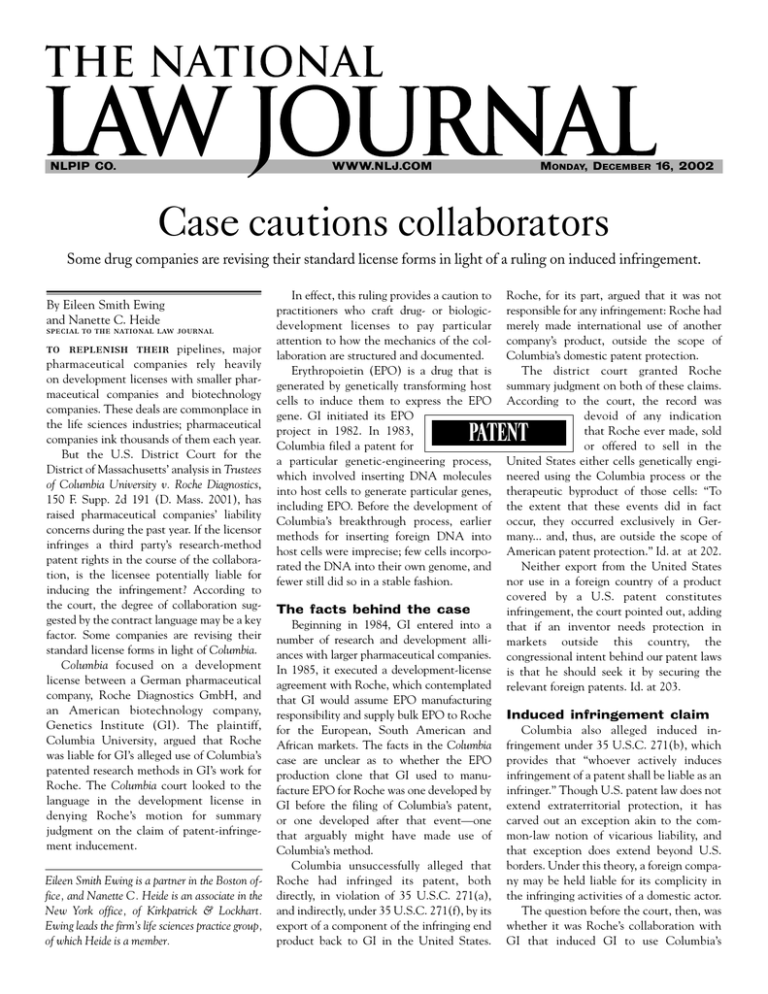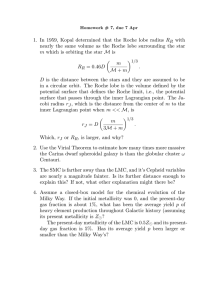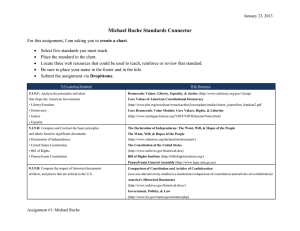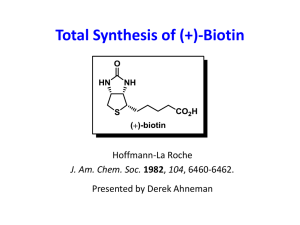
NLPIP CO.
WWW.NLJ.COM
MONDAY, DECEMBER 16, 2002
Case cautions collaborators
Some drug companies are revising their standard license forms in light of a ruling on induced infringement.
By Eileen Smith Ewing
and Nanette C. Heide
special to the national law journal
to replenish their pipelines, major
pharmaceutical companies rely heavily
on development licenses with smaller pharmaceutical companies and biotechnology
companies. These deals are commonplace in
the life sciences industries; pharmaceutical
companies ink thousands of them each year.
But the U.S. District Court for the
District of Massachusetts’ analysis in Trustees
of Columbia University v. Roche Diagnostics,
150 F. Supp. 2d 191 (D. Mass. 2001), has
raised pharmaceutical companies’ liability
concerns during the past year. If the licensor
infringes a third party’s research-method
patent rights in the course of the collaboration, is the licensee potentially liable for
inducing the infringement? According to
the court, the degree of collaboration suggested by the contract language may be a key
factor. Some companies are revising their
standard license forms in light of Columbia.
Columbia focused on a development
license between a German pharmaceutical
company, Roche Diagnostics GmbH, and
an American biotechnology company,
Genetics Institute (GI). The plaintiff,
Columbia University, argued that Roche
was liable for GI’s alleged use of Columbia’s
patented research methods in GI’s work for
Roche. The Columbia court looked to the
language in the development license in
denying Roche’s motion for summary
judgment on the claim of patent-infringement inducement.
Eileen Smith Ewing is a partner in the Boston office, and Nanette C. Heide is an associate in the
New York office, of Kirkpatrick & Lockhart.
Ewing leads the firm’s life sciences practice group,
of which Heide is a member.
In effect, this ruling provides a caution to
practitioners who craft drug- or biologicdevelopment licenses to pay particular
attention to how the mechanics of the collaboration are structured and documented.
Erythropoietin (EPO) is a drug that is
generated by genetically transforming host
cells to induce them to express the EPO
gene. GI initiated its EPO
project in 1982. In 1983,
Columbia filed a patent for
a particular genetic-engineering process,
which involved inserting DNA molecules
into host cells to generate particular genes,
including EPO. Before the development of
Columbia’s breakthrough process, earlier
methods for inserting foreign DNA into
host cells were imprecise; few cells incorporated the DNA into their own genome, and
fewer still did so in a stable fashion.
Roche, for its part, argued that it was not
responsible for any infringement: Roche had
merely made international use of another
company’s product, outside the scope of
Columbia’s domestic patent protection.
The district court granted Roche
summary judgment on both of these claims.
According to the court, the record was
devoid of any indication
that Roche ever made, sold
or offered to sell in the
United States either cells genetically engineered using the Columbia process or the
therapeutic byproduct of those cells: “To
the extent that these events did in fact
occur, they occurred exclusively in Germany... and, thus, are outside the scope of
American patent protection.” Id. at at 202.
Neither export from the United States
nor use in a foreign country of a product
covered by a U.S. patent constitutes
infringement, the court pointed out, adding
that if an inventor needs protection in
markets outside this country, the
congressional intent behind our patent laws
is that he should seek it by securing the
relevant foreign patents. Id. at 203.
PATENT
The facts behind the case
Beginning in 1984, GI entered into a
number of research and development alliances with larger pharmaceutical companies.
In 1985, it executed a development-license
agreement with Roche, which contemplated
that GI would assume EPO manufacturing
responsibility and supply bulk EPO to Roche
for the European, South American and
African markets. The facts in the Columbia
case are unclear as to whether the EPO
production clone that GI used to manufacture EPO for Roche was one developed by
GI before the filing of Columbia’s patent,
or one developed after that event—one
that arguably might have made use of
Columbia’s method.
Columbia unsuccessfully alleged that
Roche had infringed its patent, both
directly, in violation of 35 U.S.C. 271(a),
and indirectly, under 35 U.S.C. 271(f), by its
export of a component of the infringing end
product back to GI in the United States.
Induced infringement claim
Columbia also alleged induced infringement under 35 U.S.C. 271(b), which
provides that “whoever actively induces
infringement of a patent shall be liable as an
infringer.” Though U.S. patent law does not
extend extraterritorial protection, it has
carved out an exception akin to the common-law notion of vicarious liability, and
that exception does extend beyond U.S.
borders. Under this theory, a foreign company may be held liable for its complicity in
the infringing activities of a domestic actor.
The question before the court, then, was
whether it was Roche’s collaboration with
GI that induced GI to use Columbia’s
THE NATIONAL LAW JOURNAL
patented methods in producing genetically
engineered cell lines for Roche. Central to
the court’s determination was Roche’s
involvement in facilitating GI’s alleged
infringing conduct.
Columbia contended that Roche was
aware of Columbia’s patent when it gave its
financial support and encouragement to GI’s
infringing acts in creating EPO-generating
host cells. In arguing that Roche vicariously
induced GI to infringe Columbia’s patent,
Columbia focused on the development
license agreement between GI and Roche.
Columbia pointed out that the agreement
was not a traditional buy-sell arrangement,
but rather a collaboration whereby GI was
compensated for researching and developing
a commercially feasible process to produce a
product. Columbia claimed
that the terms of the agreement
called for Roche to play a
proactive role in dictating the
nature and scope of GI’s EPO
production activities—in other
words, Roche called the shots.
On the other hand, Roche
maintained that, regardless of
the other collaborative aspects
of the arrangement, Roche did not induce
infringement because Roche had no control
over what development process GI chose to
use in developing its end product, and
Roche did not participate in selecting
whatever process was used. Roche’s primary
responsibility under the license agreement
was for marketing the end product overseas.
MONDAY, DECEMBER 16, 2002
Party at its offices and laboratories, and to
discuss the Project work and its results in
detail with the technical personnel and
consultants of the other Party.”
■ The expectation of disclosure of confidential information about the manufacture process
to Roche by GI. The agreement provided
that GI was to provide: “know-how as well
as the production clone in confidence to
[Roche]...to enable [Roche] to manufacture
and produce Licensed Compound as well
as Licensed Products.”
■ Joint intellectual property ownership
provisions. The agreement stated: “The
Parties shall own jointly the entire right,
title and interest in and to all patent and
other rights in any product, method or
apparatus conceived, reduced to practice
or developed jointly...in the
course of the Project.”
The court found support
for a “concerted partnership”
because the development
license agreement specified
that Roche would fund a
research project “utilizing
recombinant DNA technology
for producing [EPO] on a commercially feasible basis for use in humans.”
The agreement also committed Roche to
pay royalties to GI, in exchange for what
Roche characterized as a license to GI-manufactured EPO overseas.
The linchpin for liability under 35
U.S.C. 271(b) is an actor’s specific intent to
induce and the steps undertaken actively to
encourage or advance the infringement.
The Columbia court emphasized the extent
of control Roche exercised over the production of the infringing product and found
that the parties had negotiated a highly
integrated collaboration. The agreement
stated: “[Roche] desires that GI, on behalf
of and in collaboration with [Roche],
undertake a research and development project utilizing recombinant DNA technology
for producing erythropoietin on a commercially feasible basis for use in humans. In
return for certain rights under the patents
and know-how developed by GI, [Roche]
will financially support the research and
development activities of GI and will pay
GI the royalties provided herein.”
Moreover, Roche was the principal
underwriter of the research, and it had
an exclusive license to use the technology
outside the United States and to prosecute
foreign patent applications.
Case could
imperil
licenses.
License agreement language
Roche and GI had signed a development
license agreement on Oct. 8, 1985,
contemplating that GI would assume EPO
manufacturing responsibility and supply
bulk EPO to Roche. In reviewing the
agreement, the court determined that the
language was not, as Roche had suggested in
its arguments, that of a passive buy-sell
agreement. The nature and degree of the
collaboration implied by the contractual
language, in the court’s view, implied a
much more interdependent relationship.
The court focused on several specific terms
of the agreement:
■ The parties’ right to inspect work and
determine if the work was proceeding as
contracted. The license agreement provided:
“Each Party shall have the right to arrange
for its employees and outside consultants
involved in the Project to visit the other
The Columbia court reasoned that the
absence of meaningful control over the
production of an item may equal the
absence of actual intent to induce infringement. Nonetheless, at least one subsequent
court has found that it is not necessary that
an inducer must, as a matter of law, have
control over the production of the actual
infringer. See Donnelly Corp. v. Reitter &
Schefenacker GmbH & Co. KG., 189 F.
Supp. 2d 696 (W.D. Mich. 2002).
Perhaps pivotal to Columbia was the
court’s finding that the agreement explicitly
contemplated the possibility of infringement. The court specifically stated that this
language supported Columbia’s claim: “The
Parties recognize that the undertaking of
the Project and the marketing of Licensed
Products involves some degree of risks of
patent infringement....[Roche] may deduct
from
royalties...payments
(including
without limitation royalties, option fees or
license fees) to one or more third parties to
obtain a license or similar right in the
absence of which the Licensed Product or
Licensed Compound could not legally be
manufactured or sold.”
Those who draft development license
agreements will note that the indicia
of collaboration identified by the Columbia
court—rights of inspection, information
exchange, joint intellectual property
ownership, indemnification against patentinfringement claims—are commonplace in
development licenses. So, too, is the
scenario that the developing party may, in
the course of identifying promising drugs,
use screening or other research methods
patented by third parties.
Whether GI’s method of producing
genetically engineered cell lines did in fact
infringe Columbia’s patent, and whether
Roche induced the alleged infringement,
are matters to be ruled on in a subsequent
court decision. However, Columbia raises
a thorny question as to whether major
industry players funding thousands of such
development projects in a given year
could be held accountable for inducing
infringement, by virtue of the language of
collaboration commonly found in their
development agreements. NLJ
This article is reprinted with permission from the
December 16, 2002 edition of THE NATIONAL
LAW JOURNAL. © 2002 NLP IP Company.
All rights reserved. Further duplication without
permission is prohibited. For information contact,
American Lawyer Media, Reprint Department at
800-888-8300 x6111. #005-01-03-0001






